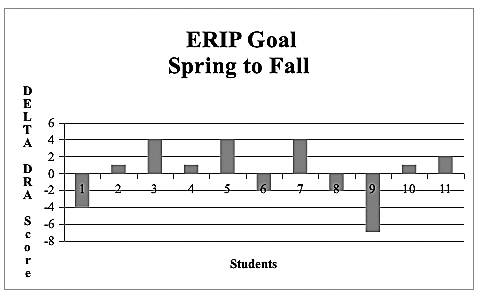by Tom Owens
The Early Reading Intervention Project created and taught by Orcas Island Elementary School and funded by community donations was completed in August. Our goal was to eliminate the usual summer reading skills loss most children see over the summer. The measure we used was the Developmental Reading Assessment, the statewide reading skills evaluation tool.
The graph pictured here illustrates the results of the ERIP.
These are DRA scores for each of the 11 students over the entire summer — spring to fall. I have shown the students who maintained their reading level (broke even) as +1’s so that they would be visible on the graph. Four students increased their reading skills, three broke even and four declined. During the period from the end of school to the beginning of the summer class, nine students lost reading skills and two broke even. During the class, all students gained reading skills. Without the class, each of these students would have started the new school year with significantly lower reading skills.
Funding for ERIP came from these community organizations:
Orcas Island Education Foundation; Kiwanis Club; Lions Club; American Legion and Sons of the American Legion.
Twelve private people made generous donations: Janet Alderton; Bob and Wendy Darby; Walt Corbin; Bill Miller and Diane Boteler; Chris White; Stan and Kay Miller; Jim Bredouw; Rick and Marlace Hughes; Tye Tyson; Boris Luchterhand; Clyde and April Duke; Tom Owens and Marjorie Greau.
The eight volunteer teachers did an amazing job.
Peg Manning, Loretta Hunt, Lene Symes, Edee O’Syncrasies, Jessica Giasullo, May McDuffie Taylor, Page Bristow and Toby Smith.
Glenda Smith, the elementary school’s reading specialist, was the creative force behind this class.
Lorena Stankvich, the elementary school principal, supported the ERIP from concept through execution.
Next summer’s program will see some changes. To eliminate vacation conflicts, enrollment will start in early May, using early DRA scores as criteria. The class size may be limited to 12 to fit the one classroom model. Measures to increase attendance will be considered. The low student/teacher ratio will be maintained.




